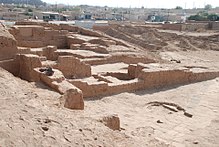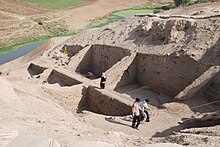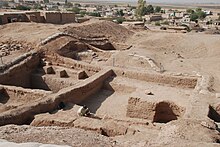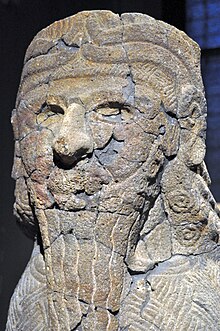Tell Halaf
Coordinates: 36 ° 49 ′ 36.1 ″ N , 40 ° 2 ′ 21.6 ″ E
Tell Halaf ( Arabic تل حلف, DMG Tall Ḥalaf , Aramaic ܬܠ ܚܠܦ, Tel Ḥalaf ) is a settlement mound in northeast Syria . In prehistoric times there was a settlement of the Halaf culture, named after this first place of discovery, at this location and since the 2nd millennium BC. The city of Gozan (also Gosan , Akkadian : Guzāna , Greek for Ptolemaios : Γαυζανις ). Significant finds date from the Assyrian period to the middle of the 1st millennium BC. Chr.
location
Tell Halaf is located in the Syrian part of the Jazira region , three kilometers west of Raʾs al-ʿAin and a few hundred meters from the Turkish border. At the foot of the hill, the Chabur flows past, which has its source in Turkey, but draws most of its water from nearby karst springs. The area is part of the historical region of Upper Mesopotamia .
history
In the late Neolithic and early Chalcolithic times the place was already settled and gave its name as an eponymous site of a village-like cultural stage, the Halaf period (around 6000 to 5300 BC). Their ceramic style, which is widespread over large areas of the Near East , is characterized by multicolored geometric and figural paintings. The preferred patterns are double ax , Maltese cross , bucranion , lying bulls and birds. The subsequent archaeological layer is known as the Obed culture . After the end of the Halaf period, the place seems to have been deserted for a long period of time. The investigations of Tell Fecheriye on the southern outskirts of Raʾs al-ʿAin, which continued in 2009, provided evidence of settlement there for the time when Tell Halaf was uninhabited. The question of why there was obviously a settlement in multiple changes between these two sites is still unanswered.
The city of Gozan was located in an area that dates back to the middle of the 2nd millennium BC. BC formed the center of the Hurrian state Mitanni . It is believed that Gozan was Hurrian dominated before it became the capital of the Aramaic state of Bit-Bahiani . The Aramaic ruler best documented by inscriptions was Kapara (the son of Hadiani). In the absence of synchronisms , one can only assume that his rule over Bit-Bahiani was around the 10th or 9th century BC. Is to be set. He had a monumental building ( Bit Hilani ) adorned with numerous sculptures on the citadel . His inscriptions found there also attest to the place name Guzana .
The Assyrian king Adad-Nirari II. (911-891) defeated the Aramaic king Abisalāmu (Absalom) and received tribute from Gozan. As an inscription from Tell Fecheriye shows, the area around Gozan was considered an Assyrian province as early as the 9th century (at least temporarily), even though it was initially administered by a local dynasty. 808 and 759–758 there were Aramaic uprisings, which were led by the Assyrians under Adad-Nirari III. (809-783) and Assur-Dan III. (772-755) were knocked down. Perhaps these are the events referred to in Isaiah 37:12.
The city became the seat of the Assyrian governors of the Guzana Province at the end of the 9th century - a sign that Bit Bachianis was incorporated into the Assyrian Empire around this time. These governors were in turn subordinate to the governors of Nasibina. In the east of the old citadel they created their palace (northeast palace), while a new temple was built in the lower town. However, the cultic and religious center of the Assyrian province (like that of the Aramaic principality before) was in Sikani, about three kilometers away. A number of Assyrian texts attest to the high taxes the province had to pay in the form of barley, rye, human labor and cattle. In the 2nd book of Kings 17: 6; 18.11 it is mentioned that Israelites from the northern kingdom after the destruction of Samaria in 721 BC. Besides Halach and Medien, the Assyrians also deported them to the Gozan region. According to the 1st book of Chronicles 5:26, Tiglath-Pilesar III. (744–727) deported Israelites to this region - but in historical retrospect this may be a confusion between the deportations of Tiglat-Pilesar and those of Sargon II (722–705). In any case, Hebrew names such as Hoschea , Halbishu from Samaria , Palti-Jahu , Neri-Jahu and Azari-Jahu can be found in texts from Tell Halaf and a letter from Gozan to Asarhaddon from the 7th century .
After the collapse of the Assyrian Empire, the city became a Babylonian colony in 612 . As a result, it lost further importance, but was inhabited until the Islamic period.
Cityscape
There are no recognizable architectural remains of the small, simple adobe houses of the Halaf period.
Kapara had a citadel extended in the southern area of the hill and built residential buildings and a ceremonial palace (western palace) in the shape of a Bit Hilani with figure columns at the entrance portal. The architecture of the facade resembled an antenna temple . On both sides of the weather god Teššup , who stood on his bull, his wife, the sun goddess Ḫepat , and their son Šarruma , each standing on a lion, formed the caryatids who carried the architrave . Mighty, but roughly shaped animal figures with sculpted heads protruded from the side walls of the portal. A wide flight of stairs led to the palace, which stood on a high terrace. The base of the palace was decorated with orthostats , basalt basalt relief panels that were also presented in the entrance area. Access was through the southern fortress gate and the adjoining scorpion gate. The good state of preservation of the stone figures when they were uncovered could be caused by a fire disaster during the suppressed uprising against the Assyrians in 759 BC. When the collapsing roof buried everything under a thick layer of clay.
In a cult room to the north from Kapara's time, Oppenheim dug up a double seated portrait, a male figure (weather god), an adobe bench and a square altar. The room probably served the ancestor cult.
The surrounding citadel wall had bastions and enclosed an upper town of 5.1 hectares. It led from the West Palace at an angle to the Assyrian Northeast Palace with a large, almost square inner courtyard from the end of the 9th century BC. The palace had living rooms with bathrooms and a separate administrative wing. A large audience room was missing and the West Palace was probably used to receive guests. In between there were other stately buildings in a large area. The southern lower town was surrounded by an outer wall that bordered 50 hectares.
Research history
In November 1899, Max von Oppenheim examined the hill for three days without being able to evaluate or recover his findings. He was only able to return in August 1911 with an excavation team and extensive equipment, which included a field railway with 22 dump trucks and the material for building an expedition house. The team included five architects, a photographer, two secretaries, a doctor and 200 local workers. Until 1913 and, after an interruption due to the First World War , from 1927 to 1929, parts of the palace were uncovered in the area of the citadel, parts of the city wall and some burial chambers nearby. The 10th century BC West Palace Chr. Possessed larger-than-life figure columns made of basalt as a unique building decoration. After the find was divided, one part of these figures ended up in the National Museum in Aleppo , the other part was taken to Berlin through Oppenheim , where they were housed in their own museum building and were badly damaged in the Second World War . A copy of these pillars forms the entrance to the Aleppo National Museum .
In a crypt in front of the West Palace, rich accessories (gold applications on clothing) were found. Three other graves in the city area yielded human figures, which probably served the ancestor cult. Furthermore, the remains of a roughly 6000 year old settlement of the Halaf culture were uncovered.

After an 80-year break, the excavations have been carried out since the summer of 2006 by a Syrian-German team under the direction of Lutz Martin ( Vorderasiatisches Museum Berlin ), Mirko Novák ( University of Bern ), Jörg Becker ( University of Halle ) and Abd el-Masih Baghdo ( General Directorate of Antiquities and Museums Damascus) continued. The aim of the project, which is initially set to run for five years, is to further uncover the buildings on the citadel, especially in the area of the south-east bastion and to uncover the north-east palace. A third working group is researching the settlement history of the prehistoric epochs of the 6th and 5th millennium at an excavation site on the north side of the hill.
The location of the city wall is known from plans by Oppenheim; it reached far into the plain to the south. It is no longer possible to explore this area, as the Syrian government did nothing in the 1980s to prevent new village developments that now come right up to the hill. On the hill itself, the excavations are restricted by an Islamic cemetery, which may not be moved and is occasionally even re-occupied.
One of the inscriptions found on Tell Halaf, which provide information about the settlement history, is a short ancient Aramaic inscription on a limestone altar with the name of the Aramaic ruler Zdnt ( zdnt.b'l.zy. Bhy [n] , "Zidant, the lord of the tribe Bachiani "). However, the name Bachiani is missing from the inscriptions of King Kapara. He was immortalized in several short inscriptions on stone slabs on Bit Hilani, which are used for his approximate dating. To the south of the Assyrian palace, tablets were discovered in the citadel, the location of which is known as the archive of Mannu-ki-mat-Assur. The from the beginning of the 8th century BC. Texts from bookkeeping and letters dating back to the 3rd century BC deal with the payment of soldiers and their equipment, the sending of messengers, justice, taxation and official ceremonies. The Il-manani archive from 615 to 611 BC Chr. Contained a deed of the purchase of slaves in addition to deeds of debt.
A coincidental find from 1989 was the torso of a seated statue made of black basalt, which depicts a scribe named Kammaki, possibly belonging to the local royal family, and dates back to the middle of the 8th century BC. Is dated. A three-line cuneiform text is preserved on the front of the skirt, which contains the name of the sitter and an invocation to the Sumerian-Assyrian god of protection and underworld, Enmesarra.
Collection history
Max von Oppenheim established a foundation for his excavations and research, the Max Freiherr von Oppenheim Foundation . Oppenheim put the Syrian part of the finds together in a small museum in Aleppo. A statue of a god or ruler can be seen today in the Archaeological Museum in Adana, Turkey . Oppenheim planned to transfer the finds from Tell Halaf brought to Germany to the Museum of the Middle East in return for an expense allowance. After no agreement could be reached in the negotiations, Oppenheim received from the Technical University of Berlin in Franklinstr. 6 in Berlin-Charlottenburg provided a former factory hall in which he could exhibit the findings from Tell Halaf. In the permanent exhibition that opened there on July 15, 1930, Oppenheim u. a. also a reconstruction of the facade of the palace of Kapara.
The museum was hit by a British Royal Air Force incendiary bomb on the night of November 23-24, 1943, and burned to the ground. The limestone and plaster exhibits burned completely. After being exposed to the heat of the phosphorus bombs, then to the extinguishing water and then to the winter cold, the basalt works of art burst into around 27,000 fragments. Oppenheim made sure that the remains were recovered and brought into the cellar vault of the Pergamon Museum. The remnants of the collection, which was broken into thousands of fragments, are now in the State Museums of Prussian Cultural Heritage in Berlin. The rubble was considered irreversible and was forgotten.
From 2002 to 2009, the holdings of the Max von Oppenheim Collection of the State Museums were reviewed and cataloged by a research team led by Nadja Cholidis and Lutz Martin . The partly monumental sculptures were painstakingly put together from thousands of fragments. The reconstructions were presented in a comprehensive publication in 2010.
From January to August 2011, a special exhibition on these sculptures took place in the north wing of the Pergamon Museum in Berlin . Nadja Cholidis and Lutz Martin published a catalog for this in 2011. From April to August 2014, the Bundeskunsthalle showed the sculptures in connection with an exhibition on von Oppenheim. It was curated by Ulrike Dubiel and supplemented by a number of larger exhibits that could not be shown in Berlin, as well as loans from the Musée du Louvre and the British Museum .
literature
- Abd el-Masih Baghdo, Lutz Martin , Mirko Novák, Winfried Orthmann : Excavations on Tell Halaf in northeast Syria. Preliminary report on the first and second excavation campaigns in 2006 and 2007. Harrassowitz, Wiesbaden 2009, ISBN 978-3-447-06068-4 .
- Abd el-Masih Baghdo, Lutz Martin , Mirko Novák, Winfried Orthmann : Excavations on Tell Halaf in northeast Syria. Preliminary report on the third to fifth excavation campaigns 2008–2010. Harrassowitz, Wiesbaden 2012, ISBN 978-3-447-06828-4 .
- Jörg Becker : Tell Halaf. The prehistoric layers - new insights. in: Dominik Bonatz , Lutz Martin (ed.): 100 years of archaeological field research in northeast Syria - a balance . Harrassowitz, Wiesbaden 2013, pp. 45-64, ISBN 978-3-447-10009-0 .
- Mirko Novák : Gozan and Guzana. Anatolians, Aramaeans and Assyrians in Tell Halaf. in: Dominik Bonatz, Lutz Martin (Hrsg.): 100 Years of Archaeological Field Research in Northeast Syria - a Balance Harrassowitz, Wiesbaden 2013, pp. 259–281, ISBN 978-3-447-10009-0 .
- Nadja Cholidis, Lutz Martin: Cheer up! Courage up! and humor high! Tell Halaf and its excavator Max Freiherr von Oppenheim. Philipp von Zabern, Mainz 2002, ISBN 3-8053-2853-2 .
- Nadja Cholidis, Lutz Martin: Tell Halaf. Monuments destroyed in the war and their restoration. De Gruyter, Berlin 2010, ISBN 978-3-11-022935-6 .
- Nadja Cholidis, Lutz Martin (ed.): The saved gods from the palace of Tell Halaf. Volume accompanying the exhibition, Schnell & Steiner, Regensburg 2011, ISBN 978-3-7954-2450-3 .
- Ulrike Dubiel, Lutz Martin: Bull from Aleppo in Berlin. Pictures from Tell Halaf (Syria) are being restored , in: Antike Welt 2004, issue 3, pp. 40–43.
- Gabriele Elsen, Mirko Novák: The Tall Halāf and the Tall Halāf Museum , in: Das Altertum 40, 1994, pp. 115–126, ISSN 0002-6646
- Johannes Friedrich , Gerhard Rudolf Meyer, Arthur Ungnad , Ernst F. Weidner : The inscriptions from Tell Halaf. Archive for Orient Research. Supplement 6. Berlin 1940. [Reprint: Osnabrück 1967].
- Gerhard Rudolf Meyer : The Tell Halaf. A ruin site in northern Syria. Special issue Wissenschaftliche Annalen, Berlin 1958.
- Mirko Novák: The religious policy of the Aramaic principalities in the 1st millennium BC Chr. , In: M. Hutter, S. Hutter-Braunsar (ed.): Official religion, local cults and individual religion. Old Orient and Old Testament 318, Münster 2004, pp. 319–346. ( online ).
- Max Freiherr von Oppenheim : The Tell Halaf. A new culture in the oldest Mesopotamia. FA Brockhaus, Leipzig 1931. (Photomechanical reprint De Gruyter, Berlin 1966.)
- Winfried Orthmann : The Aramaic-Assyrian city of Guzana. A look back at Max von Oppenheim's excavations in Tell Halaf. Writings of the Max Freiherr von Oppenheim Foundation. H. 15. Harrassowitz, Wiesbaden 2005, ISBN 3-447-05106-X .
- Gabriele Teichmann and Gisela Völger (eds.): Fascination Orient. Max Freiherr von Oppenheim. Researcher, collector, diplomat. Max Freiherr von Oppenheim Foundation, DuMont, Cologne 2003, ISBN 3-8321-5849-9 .
Movies
- "Saved Gods" risen. News broadcast, Germany, 2011, 2:34 min., Director: Griet von Petersdorff, production: RBB , tagesschau.de , first broadcast: January 27, 2011.
- In secret mission. The find of Tell Halaf. Documentary and docu-drama , Germany, 2011, 44 min., Script and direction: directors: Saskia Weisheit, Kay Siering, production: ZDF , first broadcast: January 9, 2011.
Web links
- Tell Halaf excavation project
- Project website University of Munich
- Tell Halaf project. - Vorderasiatisches Museum Berlin
- Katharina Lange: Ethnography and Archeology - The workers at Tell Halaf. In: The saved gods from the palace of Tell Halaf. ISBN 3-8321-5849-9 , pp. 155-162, PDF, 3.93 MB.
- Martina Doering: The 27,000-stone puzzle. ( Memento from September 3, 2011 in the Internet Archive ) Berliner Zeitung, September 3, 2011 (at Internet Archive)
Individual evidence
- ^ Leonard Woolley : Mesopotamia and the Middle East. The art of the Middle East. Holle Verlag, Baden-Baden 1961, p. 148 describes the design as "provincial"; On p. 144 he speaks of “raw and bizarre innovations”.
- ↑ Thilo Jordan: The spades are crunching again on Tell Halaf. ( Memento of the original from January 19, 2011 in the Internet Archive ) Info: The archive link was inserted automatically and has not yet been checked. Please check the original and archive link according to the instructions and then remove this notice. In: Archeology online, November 17, 2006
- ^ Mirko Novák: Texts. Tell Halaf excavation project
- ↑ Wolfgang Röllig: The seat image of the Kammaki from the Halaf part. (PDF; 5.3 MB) In: Reinhard Dittmann, Christian Eder , Bruno Jacobs : (Ed.): Ancient Studies in Dialog. Festschrift for Wolfram Nagel (= Old Orient and Old Testament 306). Ugarit-Verlag, Münster 2003, pp. 421-432, ISBN 978-3934628410
- ^ Tell Halaf project: Max von Oppenheim. Vorderasiatisches Museum Berlin
- ↑ Nadja Cholidis, Lutz Martin: Tell Halaf. Monuments destroyed in the war and their restoration. De Gruyter, Berlin 2010, pp. 395-400.
- ↑ Nadja Cholidis, Lutz Martin: Tell Halaf. Monuments destroyed in the war and their restoration. De Gruyter, Berlin 2010, ISBN 978-3-11-022935-6 .
- ↑ Nadja Cholidis, Lutz Martin (ed.): The saved gods from the palace of Tell Halaf. Volume accompanying the exhibition, Schnell & Steiner, Regensburg 2011, ISBN 978-3-7954-2450-3 .
- ^ Bundeskunsthalle: Adventure Orient Retrieved on May 18, 2014.





